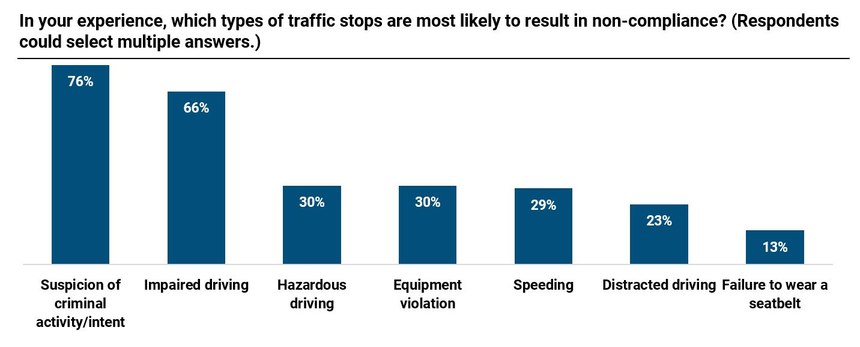Read about cops’ concerns regarding traffic stop safety, training and tactics
Nancy Perry, Police1.com
Traffic stops and vehicle contacts put police officers at a tactical disadvantage, with officer safety further compromised when faced with non-compliant drivers. To better understand officers’ experiences, perceptions, training and tactics for non-compliance during traffic stops, Police1 surveyed more than 1,000 patrol officers.
To view the complete results, fill out the form below to download the survey.
SURVEY METHODOLOGY AND RESPONDENT DEMOGRAPHICS
Police1 developed a 29-question survey, open from April 22, 2021, to May 4, 2021. A total of 1,036 responses were collected using a Microsoft Form.
Respondents were fairly evenly divided regarding location and years served in law enforcement. Of those surveyed, 24% serve a rural response area, 42% serve a suburban response area and 34% serve an urban response area.
A third of respondents had 10-20 years of law enforcement experience and a quarter had 21-30 years of experience; a third had nine years or less on the job and 10% had more than 30 years on the job.

TRAFFIC STOP ACTIVITY
We asked respondents to rank the most common reason for traffic stops in their jurisdiction. Not surprisingly, especially since COVID-19 lockdowns, speeding was overwhelmingly listed as the number one reason for traffic stops at 43% followed by equipment violations at 24%. Only 13% of respondents rated distracted driving as the number one reason for traffic stops, pretext stops and hazardous driving were rated number one by only 9% and 7% of respondents respectively.

While 2020 saw a huge increase in speeding violations nationwide, in regard to non-speeding traffic violations, 41% of respondents said they had decreased in the past year and 17% had stayed the same. Forty-two percent said they had increased.

We wanted to know if officers had changed their behavior regarding traffic stops since 2019 and nearly two-thirds (59%) of those who responded said they were less likely to stop a vehicle in violation of traffic laws while on patrol than two years ago, while a third (36%) said there was no change. Only 2% were more likely to stop a vehicle.
COMPLIANCE BEHAVIORS
We asked how compliance behaviors during traffic stops had changed over the past year. While half of the respondents said it had stayed the same, 49% said compliance had worsened.
We asked respondents to select the types of traffic stops most likely to result in non-compliance. Suspicion of criminal intent and impaired driving were selected most often, with 76% and 66% of respondents selecting one or both. Just over a third of respondents said hazardous driving, equipment violations and speeding were likely to result in non-compliance. Just over one in five respondents selected distracted driving and just over 10% selected failure to wear a seatbelt.

The most common non-compliance behavior encountered was a failure to follow commands (42%) followed by a failure to answer questions (24%). Around 10% of respondents said refusal to show a driver’s license and other documents or furtive movements.

We asked respondents to list the actions they did at every traffic stop, whether as a result of personal habits or policies. Nearly all the respondents indicated that they notify dispatch they are on a traffic stop and tell the driver the reason they were stopped. They also request the driver’s license, registration and proof of insurance and scan the vehicle interior for hazards. Two-thirds of the respondents activate their body-worn camera during traffic stops and 57% active the dash camera; 62% percent conduct a license plate check before contact. Half of those surveyed touch the vehicle to leave their prints, while only 4% of the officers who answered this survey call for backup.
Read Full Report Here: https://www.police1.com/traffic-patrol/articles/police-research-1000-cops-address-non-compliance-during-traffic-stops-C3mPToqhCR2O4Dxu/





